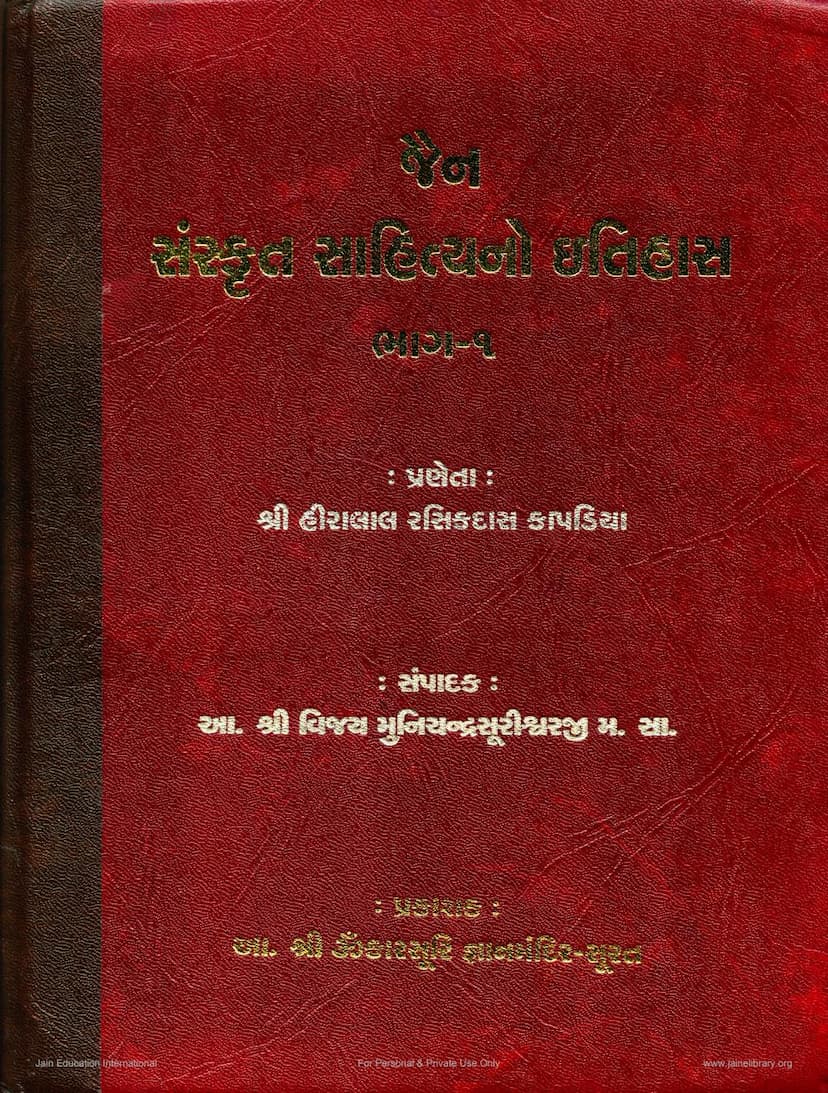Jain Sanskrit Sahityano Itihas Part 01
Added to library: September 2, 2025

Summary
Here's a comprehensive summary of the Jain Sanskrit Sahityano Itihas Part 01, authored by Hiralal Rasikdas Kapadia and edited by Acharya Vijay Munichandrasuri:
Title: Jain Sanskrit Sahityano Itihas Part 01 (A History of Jain Sanskrit Literature, Volume 1) Author: Hiralal Rasikdas Kapadia Editor: Acharya Vijay Munichandrasuri M.S. Publisher: Acharya Shri Omkarsuri Gyan Mandir, Surat
Overall Purpose and Context:
This book is a crucial and valuable work that aims to systematically chronicle the history of Jain literature written in the Sanskrit language. It serves as a foundational text for understanding the vast and diverse literary contributions made by Jain scholars and practitioners over centuries. The re-publication of this work, originally published in three volumes, highlights its enduring importance and the current unavailability of the earlier editions.
Key Aspects and Content Highlights:
-
Authoritative Scholarship: The work is a product of meticulous research by Hiralal Rasikdas Kapadia, a scholar with a deep understanding of Jain literature. The re-publication is overseen by Acharya Vijay Munichandrasuri, ensuring scholarly accuracy and relevance.
-
Comprehensive Scope (Volume 1): This first volume focuses specifically on "Sarvajanik Sahitya" (Secular Literature). This means it covers Jain literary works in Sanskrit that deal with subjects common to all, rather than exclusively religious or sectarian topics.
-
Subject Matter Covered (as indicated by the detailed index): The volume delves into various secular disciplines that Jain authors contributed to, including:
- Grammar (Vyakaran): A significant portion of the book is dedicated to the history and analysis of Jain Sanskrit grammars, discussing various schools, authors, and their works. This includes a detailed exploration of foundational texts like "Siddhahemchandrasuri's Vyakarana" (Panchanga Vyakarana).
- Lexicography (Kosh/Namamala): The history of Jain Sanskrit dictionaries and lexicons is explored, highlighting their compilation, purpose, and the scholars behind them.
- Prosody (Chhand Shastra): The study of meters and poetic structures in Jain Sanskrit literature.
- Poetics/Rhetoric (Alankar Shastra): The principles and theories of literary embellishment and aesthetics as presented in Jain Sanskrit works.
- Dramaturgy (Natya Shastra): The study of drama, including its principles and the Jain contribution to this field.
- Musicology (Sangeet Shastra): The exploration of music in Jain traditions and literature.
- Erotica (Kam Shastra): The study of literature related to love and sexuality within a broader cultural context.
- Architecture (Sthapatya): The principles and history of construction and design as found in Jain literature.
- Numismatics (Mudra Shastra): The study of coins and seals, though the text notes a lack of extensive Jain Sanskrit literature on this specific topic.
- Mathematics (Ganit Shastra): The significant contributions of Jain scholars to various branches of mathematics, including arithmetic and geometry.
- Astrology and Omens (Nimit Shastra): The study of auspicious and inauspshahv
- Medicine (Vaidyak Shastra): The medical knowledge and literature produced by Jain authors.
- Culinary Arts (Pak Shastra): The literature related to cooking and food.
- Sciences (Vigyan): Broadly encompassing various scientific disciplines.
- Ethics and Polity (Niti Shastra): Works dealing with moral principles, governance, and practical wisdom.
-
Detailed Analysis: The book doesn't just list works; it provides historical context, discusses the authors, their influences, the structure and content of the works, and their perceived merits or limitations.
-
Editor's Contribution: The editor, Acharya Vijay Munichandrasuri, has diligently preserved the original text of Hiralal Kapadia. Where necessary for clarity, updates, or corrections, the editor has incorporated them within square brackets
[ ], ensuring the work remains relevant and accurate for contemporary readers. -
Bibliographical Information: The volume includes extensive appendices and indices, such as author lists, book lists, and specialized indexes, which are invaluable for researchers and students of Jain literature.
-
Motivation for Re-publication: The re-publication is driven by the scarcity of the original volumes and the desire to make this vital information accessible to a wider audience, thereby aiding in the understanding and appreciation of Jain Sanskrit literature.
-
Historical Context of Jain Literature: The introductory sections and "Be Bol" (Two Words) by Muni Yashovijayji M.S. (later Acharya Yashodevsuriji M.S.) emphasize the historical need for such a work. It highlights the neglect of Jain literature by some non-Jain scholars and the importance of presenting the richness and depth of Jain traditions to the world. It also touches upon the challenges and vastness of Jain literature, including its presence in Prakrit and Gujarati alongside Sanskrit.
In essence, "Jain Sanskrit Sahityano Itihas Part 01" is a monumental scholarly endeavor to map and explain the secular Sanskrit literary heritage of the Jain tradition. It is an essential resource for anyone seeking to understand the intellectual and cultural contributions of Jainism through the lens of Sanskrit scholarship.